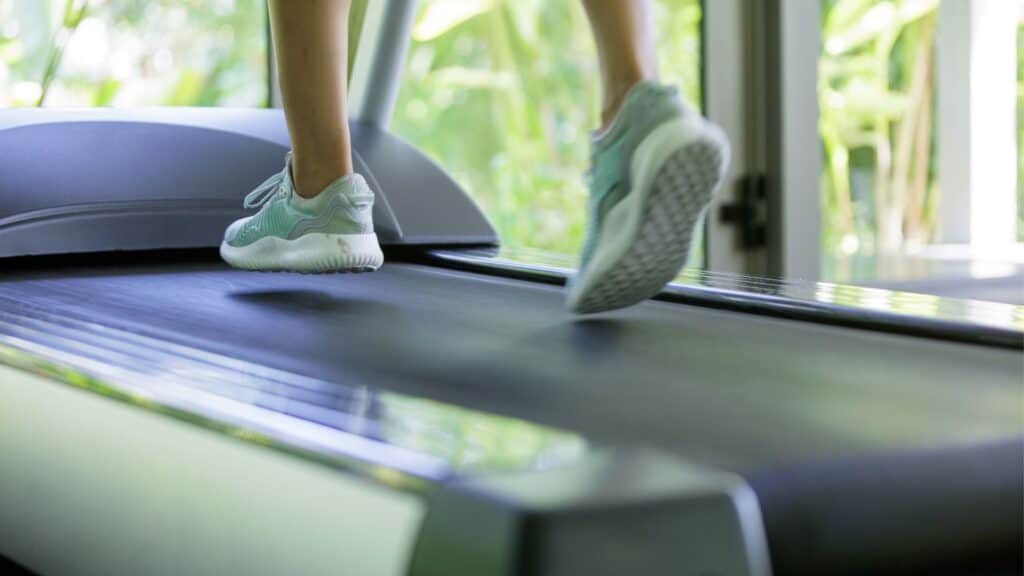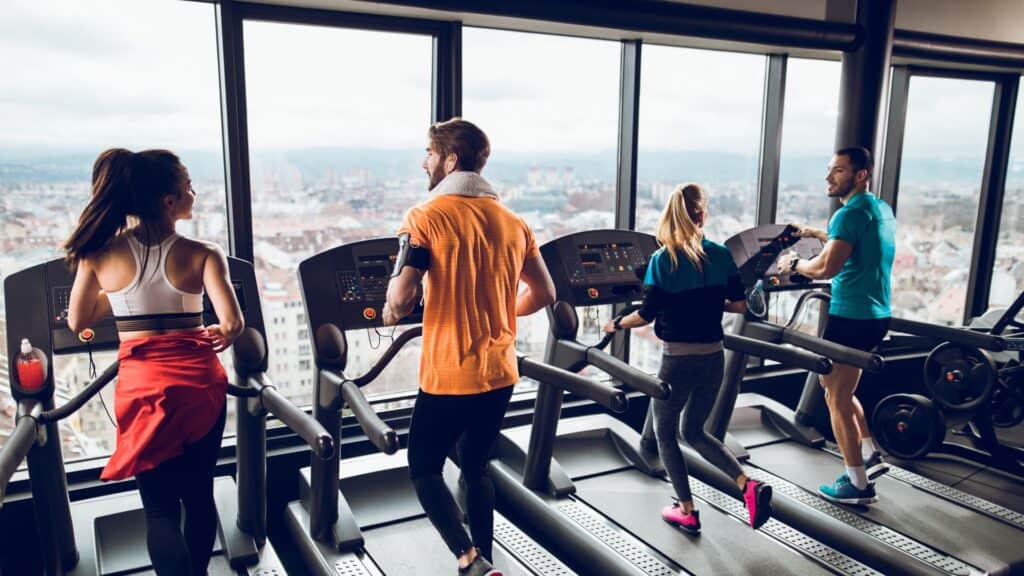Training exclusively for the Amsterdam Marathon on a treadmill might not sound very exciting to many runners.
Treadmills are often humorously called “dreadmills” because running on them can feel monotonous and tedious.
When you consider that marathon training usually lasts for 16 to 20 weeks, the idea of doing all your training runs on a treadmill might seem daunting. The repetitive nature of daily treadmill workouts can make them even more challenging.
However, it’s important to know that training for the Amsterdam Marathon on a treadmill is entirely possible. Many runners have successfully prepared for marathons using only a treadmill.
Whether you choose this route because of bad weather, safety concerns, logistical issues, a busy schedule, or personal preference, this guide will provide you with valuable tips to ensure you have a successful marathon preparation.
These tips will help you arrive at the starting line and cross the finish line in excellent shape. (well…. we can’t guarantee finishing in excellent shape, but you will finish and be ecstatic)
In this guide, we will cover the following:
- Can You Train For The Amsterdam Marathon Using A Treadmill?
- Benefits Of Training For A Marathon On A Treadmill
- Drawbacks Of Marathon Training On A Treadmill
- 5 Tips For Amsterdam Marathon Training On A Treadmill

Can You Train For The Amsterdam Marathon Using A Treadmill?
While many runners wouldn’t prefer to do all their marathon training on a treadmill, it’s totally possible, and it can lead to a strong race performance.
It doesn’t matter if you’re gearing up for your first marathon or just trying to beat your personal best (PB). Treadmill training can help you achieve your race time goals.
For many runners, the most challenging part of training for the Amsterdam Marathon is tackling those long runs. And when you throw in the treadmill, the potential for boredom can be a real struggle.
The key is to make sure that your treadmill long runs offer the same training and performance benefits as if you were running outdoors.
To achieve this success on the treadmill, it’s essential to mirror what you’d typically do during an outdoor long run.
This includes sticking to your training plan, following your nutrition strategy, and incorporating walk breaks if your program calls for them, just like you would on the road.
Also, be sure to have your nutrition handy or within easy reach for quick access.
It’s common to focus on the challenges and possible drawbacks of marathon training on a treadmill, but there are also several potential benefits to consider.
What Are The Benefits Of Training For A Marathon On A Treadmill?
Running on a treadmill offers several benefits that can make your marathon training more convenient and efficient:
- Convenience: You can train anytime, day or night, fitting it into your schedule.
- Weather and Safety: Treadmills eliminate concerns about weather, making your training safe and consistent.
- Long Runs and Pace Control: It’s easier to maintain your desired pace and complete long runs on a treadmill.
- Injury Prevention: Treadmill surfaces are soft (cushioned), reducing the strain on your joints compared to roads or trails.
- Same Energy Used: Running at a slight incline on a treadmill mimics the effort of outdoor running.
- Builds Mental Toughness: Treadmill running provides an opportunity to practice positive self-talk, which can help you manage negative thoughts and doubts during the marathon.
- Access to Essentials: You have easy access to the bathroom, fluids, and fuel during your run.
- Can Simulate A Marathon Route: Some treadmills can simulate specific race routes, helping you prepare for events like the Amsterdam Marathon.
- Multitasking: You can do other things while running on a treadmill, like catch up on TV shows or take phone calls.
- Train for Inclines: If you live in a flat area, treadmills enable training for mountain races or hilly courses. (Luckily, this is not applicable to Amsterdam.)
- Consistency: Treadmill workouts offer consistent conditions, making it easier to track your progress.
- Running With Others: You can run next to a training partner, even if you have different paces, without affecting your training.
Drawbacks Of Marathon Training On A Treadmill
Here are some downsides to treadmill training:
- Less Work for Hamstrings and Glutes: Treadmills provide some assistance, so your hamstrings and glutes may not benefit as much as they would outdoors.
- Less Agility Training: Treadmill running lacks the balance and coordination challenges of outdoor running.
- Boredom: Many people find treadmill training mind-numbing. Time seems to pass more slowly.
- Risk of Overuse Injuries: The repetitive motion on a treadmill can increase the risk of overuse injuries due to the lack of terrain variety.
- Lack of Vitamin D: Indoor training means missing out on fresh air and Vitamin D from sunlight.
- Running Alone: You can’t run with your club or friends unless they’re at the gym with you.
- No Downhill or Weather Training: Treadmill training doesn’t include downhill running or exposure to different weather conditions, which could be a problem on race day. (Note: Some modern treadmills allow slight downhill running.)
In the end, it’s all about your preference—treadmill or outdoors.
If you’ve decided to or need to train on a treadmill for your Amsterdam Marathon preparation, here are some key points to maximize the benefits of this training tool.

5 Tips For Amsterdam Marathon Training On A Treadmill
1. Best Treadmill Settings To Simulate Running Outside
Experienced runners often point out that running on a treadmill and running outdoors are quite different experiences!
For starters, outdoor running exposes you to “drag” or wind resistance, while on a treadmill, you’re essentially running in one place without pushing against the wind.
To compensate for this lack of wind resistance, experts recommend setting the treadmill to a 1% incline to mimic the energy use of outdoor running.
However, this 1% figure doesn’t account for the biomechanical effects of running on a moving belt. You also need to be cautious about always running on an incline, as you will overload your Achilles, soleus (calf), hamstring, and glute tendons.
Adding a slight incline to your treadmill workout offers benefits beyond simulating wind resistance. Here’s why:
When you run outdoors, you need to engage your glutes and hamstrings to propel yourself forward with each stride. In comparison, a constantly moving treadmill belt may do some of this propulsive work for you.
When it comes to marathon training on a treadmill, I recommend setting an incline that’s slightly above 1% but no more than 6%, depending on your specific run (which I’ll explain in more detail later).
This increased incline encourages you to work harder with your glutes and hamstrings while on the treadmill.
This prepares your legs for the challenges of outdoor running on marathon day!
If you’ve experienced knee pain, especially patellofemoral syndrome, you might find that adding an incline to your treadmill workouts helps prevent knee discomfort. It’s harder to over-stride when running uphill.
Of course, the main challenge when adding an extra incline to your treadmill runs is that you may need to slow down your pace slightly to accommodate the incline. And as mentioned, you can’t only run inclines; you also risk other overuse injuries.
2. Your Treadmill Speed Workouts For Marathon Training
Another advantage of treadmill running during marathon training is the precision it offers for your speed workouts. Many treadmills display all the necessary data right in front of you, making it easy to track your progress.
Additionally, some treadmills allow you to program specific workouts, which they will guide you through. All you have to do is run and keep up!
Here are some marathon-specific speed workouts you can try on the treadmill:
Interval Training and Hill Intervals:
Interval training involves alternating between periods of high-intensity running and recovery.
On a treadmill, this can be precisely controlled, allowing you to focus on speed and recovery durations that match your training goals.
Hill intervals, on the other hand, mimic the challenge of running uphill, which can be especially beneficial for marathoners.
It not only builds leg strength but also improves cardiovascular fitness, making it easier to tackle hilly sections during a race. Not applicable to Amsterdam, however, hill strength helps when the fatigue hits deep into a marathon.
Treadmill adjustment: Use a 0% incline for most intervals.
When adjusting the incline for hill intervals, starting at 3% is a good baseline. As you progress and become more comfortable, you can increase it to 5%.
Remember, it’s important to listen to your body and adjust the intensity if needed
Pro Tip: Before diving into these workouts, a thorough warm-up is crucial. It prepares your muscles and cardiovascular system for the upcoming intensity and reduces the risk of injury.
Time Trials:
Scheduled every four weeks in your training program, time trials serve as indicators of your progress. You can use them to adjust your training plan if needed.
Time trials are typically 5km (3.1 miles) or 8km (5 miles), depending on your time goal, and should be completed in the best time possible.
Treadmill adjustment: Choose a 1% incline for time trials.
This consistency in incline allows for more accurate tracking of your performance.
3. Doing Long Runs On A Treadmill
Marathon training on a treadmill means you’ve got to include those long runs, just like you would if you were running outdoors.
So, how far should you go on these long runs?
Well, it depends on your running experience and the finish you’re aiming for at the Amsterdam Marathon.
These long runs are crucially important because they help your body learn to keep your muscles supplied with energy and oxygen, which are vital needs for a marathon.
Beyond their physical advantages, long runs offer plenty of chances to fine-tune various aspects of your marathon preparation.
They help you get used to spending more time on your feet, gradually adapting to longer distances.
Additionally, long runs provide opportunities to experiment with different nutrition strategies, helping you figure out what suits your stomach best.
Treadmill adjustment: follow your training plan for the pace you should be running, but make sure to set the treadmill to a 1% incline for some of the running. To avoid Achilles tendonitis or similar injuries, make sure you also add in some 0% if your treadmill allows some downhill running too.
And keep in mind that these runs are supposed to be nice and easy. So, no need to push it too hard!
4. Follow A Marathon Training Plan
Whether you’re hitting the pavement or sticking to the treadmill for your marathon training, having a proper training program is essential.
Not only will it help you get ready for the big race, but it’ll also add variety to your workouts and boost your overall fitness.
With the right training plan in hand, you should be able to adapt all your workouts to the treadmill.
And remember, always pay attention to how your body feels. If you need a rest day, go for it.
Simply click here to access one of our running training programs or signature training frameworks.
5. Practice Good Treadmill Running Technique
When you’re running on a treadmill, there are a few key points to keep in mind about your running technique.
Some runners tend to adjust their style a bit when they’re on a treadmill compared to running outdoors. Here are the main things to consider:
Give Yourself Space for Arm Movement:
Make sure you don’t run too close to the front of the treadmill. If you’re too close, it can limit your natural arm swing, leading to tight shoulders.
To avoid this, you can use the safety cord as extra insurance against drifting too far forward.
Keep Your Head Up:
Many new treadmill runners tend to look down at their feet, which can affect their posture. Your head is heavy, and when you crane it forward to look down, it can change your overall posture.
Try to maintain an upright posture with your head up and looking ahead. It’s okay to glance down occasionally to check your position but quickly return your gaze forward.
Also, be cautious when running in a gym with TV monitors; stay focused to avoid accidents.
Remember these tips to ensure a smoother and safer treadmill running experience during your marathon training.

Training For Amsterdam Marathon On A Treadmill FAQs
Here are some common questions about training for the Amsterdam Marathon on a treadmill:
Is Training On A Treadmill Effective For The Amsterdam Marathon?
Yes, research shows that setting the treadmill to a 1% incline accurately mimics outdoor running’s energy costs, making it just as effective.
While it might not feel the same, treadmill training keeps you safe from bad weather, builds mental toughness, and helps you progress for the Amsterdam Marathon.
How Long Does Treadmill Training for the Amsterdam Marathon Take?
The time needed to train for a marathon varies. In general, around four months of treadmill training is enough, even if you’re a beginner.
Why Choose Treadmill Training for a Marathon?
People opt for treadmill training due to factors like bad weather or a lack of safe outdoor running options.
How Can You Make Treadmill Running More Enjoyable?
Honestly, running on a treadmill might never be as fun as running outdoors, but you can make it more bearable. Listen to audiobooks, podcasts, or energetic playlists.
Change your training style or try on-demand fitness classes with a running coach to keep things interesting



Comments are closed.